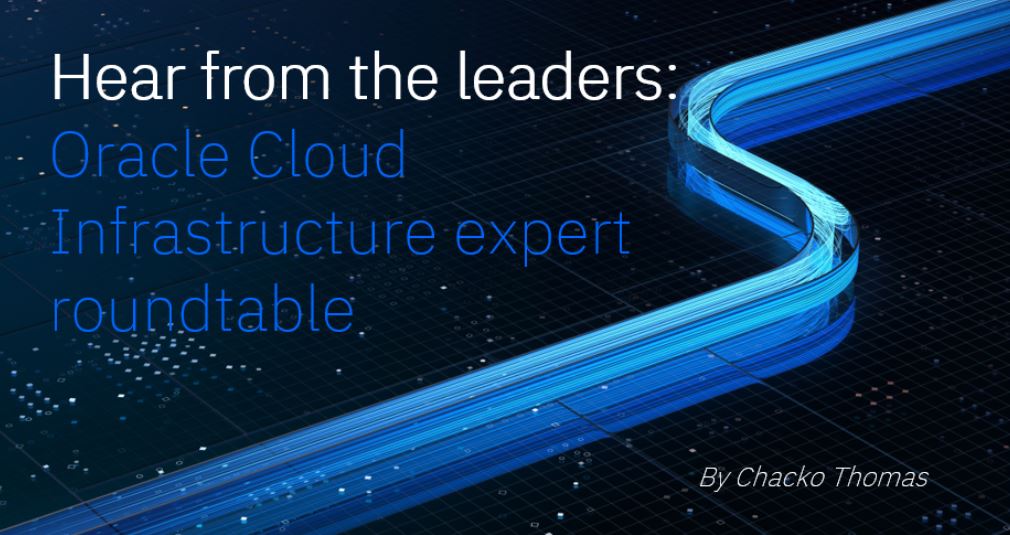
Oracle Cloud Infrastructure (OCI) is an enterprise cloud that delivers a set of platform cloud services including powerful compute, storage and networking capabilities optimized for Oracle applications. In IBM Services for Oracle, we deliver the skills you need to get your mission-critical applications running on OCI—whether you’re looking to accelerate your implementation, reduce risk or adopt a unified service portal. It’s exciting to see OCI evolve and see more organizations taking advantage of it. So, I wanted to take the opportunity to ask some Oracle leaders for their perspective on OCI today.
Vinay Kumar, SVP of Cloud Engineering at Oracle

Vinay Kumar is the senior vice president of cloud engineering at Oracle. As the former VP of OCI, Vinay has been building OCI for the past 5 years, reinventing cloud services for the enterprise one service at a time, and leading product, partners and go-to-market for OCI.
Q: There have been a lot of announcements with Oracle Cloud Infrastructure recently. Can you share some of the latest and greatest updates to OCI? Anything that you’re particularly excited about?
A: There are 2 recently announced customer-focused programs I’m proud of: Cloud Lift Services and Support Rewards.
In March 2021, we announced Oracle Cloud Lift Services where Oracle provides guidance, solution architectures and hands-on help for customers to migrate workloads to the cloud in weeks, or sometimes days, instead of months—all for no cost. This program provides a contact for technical delivery, including access to Oracle cloud engineers and activities ranging from performance analysis, application architecture, hands-on migrations and go-live support. We work with customers and partners until workloads are in production and help train staff on best practices, so they have the expertise to run the environment moving forward.
In June 2021, we announced Oracle Support Rewards, where customers earn a reward for the OCI consumption that can be used to offset their tech software license support bill for products like Oracle Database and Oracle WebLogic. Customers who choose OCI for their workloads earn at least 25% of their OCI spend as Support Rewards that reduce or even eliminate their Oracle on-premises technology licensing support bills. Oracle Support Rewards combines with other programs so customers can both save with OCI bring your own license (BYOL) pricing and get a portion of their OCI spend as Support Rewards.
Another area in OCI we’re very excited about is the expansion of big data services. For instance, we recently released a major update to Oracle Big Data Service (BDS), Oracle’s fully managed Hadoop service. The new BDS version uses Oracle’s Distribution of Apache Hadoop (ODH) and is built from the ground up to be cloud scale, and natively integrated into OCI. Our customers need a clear path to move their Hadoop workloads, including capabilities such as HIVE, Spark, and Hbase, to OCI to save money and modernize their data estate. The new BDS enables them to tackle new scenarios, integrating with Oracle Cloud and the rest of the Oracle data services, such as Autonomous Data Warehouse, Data Flow, Catalog and Object store.
An important part of a modern data platform is the ability to use AI to prepare data, manage models and more accurately predict outcomes. A good example of an AI service is the recently announced Anomaly Detection service, which helps our customers identify anomalies in multivariate data sets. Use cases of anomaly detection exist in many industry verticals, including utilities, oil and gas, transportation, manufacturing, telecommunications, banking, insurance, web businesses and IT. Anomaly Detection is part of a growing family of AI services on OCI, covering speech, vision, language and more.
Unlike other public clouds, Oracle offers an extensive SaaS portfolio of back-office and industry applications. The data generated and used by these applications creates enormous value for our customers when integrated and managed with our data platform.
Finally, Oracle offers one of the most complete free tiers in the industry where developers can actually build real, functioning applications using a stack of services, including x86 and Arm-based, compute, block storage, object storage, archive storage, a variety of databases (including JSON and NoSQL databases), Oracle Autonomous Databases, APEX application development, as well as observability offerings, such as logging and application performance monitoring, that are always free.
This gives developers a taste of what they will find on OCI, and this is just the beginning of their journey. Over the last few months, we’ve released services like:
- Bastion service, a fully managed service providing secure and SSH access to your private resources in OCI, eliminating the need to manage dedicated “jump hosts” to access these resources.
- OKE private endpoint. We added support for fully private Kubernetes clusters, providing organizations with robust access control that meets their security and compliance needs.
- OKE GPU support. Customers can configure Kubernetes clusters with GPU instances to run compute-intensive workloads such as computer vision and deep learning.
- MySQL DB service and Heatwave. A massively parallel in-memory query engine developed by Oracle Labs designed for accelerating analytic workloads. It provides 100x–1000x acceleration over MySQL and MySQL compatible databases like Aurora.
- Artifact Registry, a single location for storing, sharing and managing software packages used for application development and deployment
- Fluentd plugin for OCI. By using Fluentd-based plugins, the logging service enables you to ingest from multiple data sources, providing a single pane of glass. Users can use the Fluentd output plugin to ship logs to any destination.
- Network Visualizer. Developers can get a visual representation of their network topology in OCI, with the ability to drill down into resources for more detail.
- ARM availability, providing developers with more choice in compute instances and superior price-performance compared to any other x86 instance on a per-core basis. With 4 OCPU and 24GB RAM (available in the free tier), developers and data scientists can run real production-ready applications or easily train complex ML models.
Q: When we talk about OCI, we talk a lot about the Autonomous Database aspects and how that can help accelerate business innovation for customers. Can you help crystallize this with any real-life examples?
A: Let’s look at a couple examples of how Autonomous Database is helping companies accelerate innovation:
NilsonGroup. NilsonGroup, a leading Scandinavian shoe company, needed to refresh its hardware with a flexible, scalable computing solution in the cloud. Because of OCI’s database lifecycle management automation and autoscaling capabilities, NilsonGroup selected OCI with Oracle Autonomous Database for its modernization. OCI’s automated and self-service features help the company stay on top of security patches, prevent ransomware issues and improve productivity, and OCI security helps the company meet GDPR compliance requirements.
Learn more about how NilsonGroup cut infrastructure costs by 30% with Oracle Cloud.
Yescom USA. Yescom USA, a California-based retailer, was growing internationally and needed a fast, efficient, cost-effective way to analyze data and better understand its customers. The company chose Oracle’s Autonomous Data Warehouse and Oracle Analytics Cloud running on OCI to integrate with its existing Oracle NetSuite. The solution provides a complete cross-platform market analysis to help Yescom understand sales and profits in different platforms, times, regions and trends. As a result, Yescom better understands its customers’ needs and can optimize its supply chain while improving operations, saving costs and increasing revenue.
Regis Louis

Regis Louis is the vice president of cloud strategy, EMEA, at Oracle. Regis is responsible for securing the success of EMEA customers in their adoption of Oracle technology, and he serves as a liaison between Oracle product engineering and stakeholders across the EMEA region.
Q: European clients have heightened security and data regulations. Can you share any common concerns that European clients have around OCI—like data centers, security and so forth? How does Oracle meet and surpass these concerns?
A: The European requirements are indeed slightly different from North America’s due to data sovereignty and other regulations specific to each European country. We’ve worked on many fronts to address these concerns with OCI to allow any organisation in EMEA to adopt cloud computing while being compliant, such as:
- Security & compliance: OCI has been designed with a security-first, no-trust approach from day one to fully protect customer data (hardware through software, end-to-end encryption, security automation and continuous protection, and so on). In addition, OCI has gone through an extensive certification process to comply with major industry and local European regulations, and we’re working with local auditors in most countries to constantly expand our list of certifications. Oracle is also a day-1 member of Gaia-X, defining the framework for a European sovereign cloud.
- Data center localisation: To provide data localisation in country, we’re rapidly expanding our OCI data center presence across EMEA, expanding from 7 regions today to 14 regions in the next few months, each data center offering all OCI services. Our strategy is to offer 2 OCI regions in most countries where OCI is available to allow disaster recovery in country and help meet data sovereignty compliance requirements.
- Dedicated region Cloud@Customer: For customers unable to adopt the public cloud for technical or regulatory reasons, OCI can also be adopted inside customer’s data center. We can build the exact same architecture as available in the public cloud, with all the same services and the same SLAs, running completely within the customer’s premises, fully managed by Oracle.
All these investments and innovations are contributing to the success of adoption of OCI across EMEA.
Q: There’s no doubt that Europe is far ahead of the Americas in tackling sustainability and environmental concerns. I’m curious if there are any insights that you can share around OCI helping customers in the ever-growing sustainability trend?
A: Sustainability is indeed a growing factor in customers’ decisions for adopting cloud computing. We’ve designed OCI with clear sustainability goals in mind and are collaborating among our many stakeholders—employees, customers and partners—to identify and address our most material impacts. For example:
- We provide our cloud services on an efficient and low or no carbon infrastructure, reducing the carbon liability of our customers (for example, all European OCI data centers are 100% powered by renewable energy).
- Our hardware is designed to encompass the circular economy, diverting over 99% of e-waste from landfills.
- We’re committed to reducing our environmental impact in our operations with very aggressive goals on water and waste, and emissions reductions.
We also provide solutions that our customers use to manage their sustainability and net zero ambitions, and we’re working closely with them to help them quantify their environmental impact as they’re adopting our cloud. As a recent example, a European customer that adopted OCI has calculated a 93% reduction in its carbon footprint compared to its on-premises deployment.
With all these efforts, we’re proud of the positive impact we’re making. But there’s still much to be done, and we remain committed to the work of building a more sustainable future.
Dale Weideling

Dale Weideling is the group vice president at Oracle. With more than 25 years in the IT industry, Dale has a successful track record leading teams comprised of channel sales management, partner management, marketing, program management, technical and sales administration personnel.
Q: In Oracle’s Q3, the Gen 2 Cloud Infrastructure business added customers and grew revenue at a rate in excess of 100%. Oracle Chairman and CTO Larry Ellison said, “We are opening new regions as fast as we can to support our rapidly growing multi-billion-dollar infrastructure business.” In the May quarter, OCI grew more than 100% again. OCI has had several high-profile marquee wins, notably the videoconferencing companies Zoom Video (ZM) and 8×8 (EGHT). What patterns are you seeing with clients, and what is driving the growth of choosing OCI over other options?
A: Now that our Gen 2 Oracle Cloud Infrastructure has gained significant momentum in the market, customers are realizing its value and the impact on their businesses. Reduced costs, improved performance and enhanced security are at the top of the list for driving our growth.
We offer more choice than any other cloud provider in terms of hybrid, multicloud architecture options. Those range from public cloud locations distributed globally, full private dedicated regions in customer data centers, edge computing with Oracle Roving Edge Devices and our high-performance Exadata Cloud@Customer.
Customers are seeing huge success migrating their Oracle on-premises applications and their own custom or third-party apps to OCI. We’re also empowering modern application development using technologies like Kubernetes, Docker and Kafka.
Finally, Autonomous Database services—with self-repairing and self-optimizing features—are exclusive to OCI.
Here are some patterns we’re seeing:
- More and more customers are considering OCI in their cloud strategy as we continue to build momentum and awareness in the market. They’re hearing about the performance and price advantages we have versus other clouds and are adding us to their evaluation.
- We continue to see Oracle customers look to OCI to move their Oracle workloads, leveraging the new programs like loyalty rewards.
- And possibly most exciting, we’re seeing current customers adding additional workloads to OCI like analytics, MySQL, VMware and custom apps.
Q: What are some of the business outcomes that clients can expect with OCI?
A: I’ll answer this with some of our data in line with the growth drivers I mentioned.
Our customers are seeing more than 3x better compute price performance versus our competitors. The 5-year total cost of ownership (TCO) for OCI can be 45% cheaper. We are one-quarter of the cost for outbound bandwidth and offer 44% lower costs for high performance computing. We have 20x input/output operations per second compared to AWS for half the price.
Mazda, for example, migrated a global inventory management system tracking thousands of automotive repair parts and accessories from an on-premises system to OCI, and it has achieved a 70% increase in performance and cut its 5-year TCO in half.
From a security standpoint, a recent Cloud Threat Report found that 75% of enterprises attest to OCI’s superior security design compared to on-premises environments. Security is top of mind in all our customer engagements. And according to an IDC survey, OCI has the highest customer satisfaction (8.64/10) among all cloud vendors surveyed.
An excited future for OCI
There’s clearly a lot of excited momentum around OCI in the marketplace today. IBM has been one of Oracle’s most significant partners for 35 years. With more than 10,000 dedicated Oracle consultants, we can help organizations optimize their investment in Oracle applications.
Learn more about IBM Services for Oracle.
Many thanks to Vinay, Regis and Dale for sharing their perspectives. I can’t wait to see more customers taking advantage of OCI for their business.